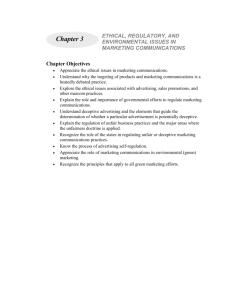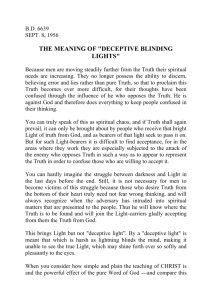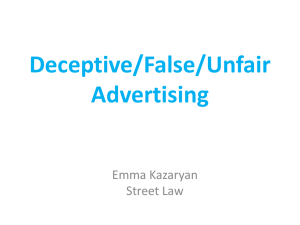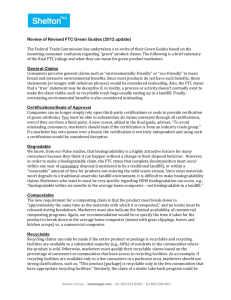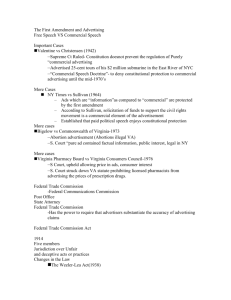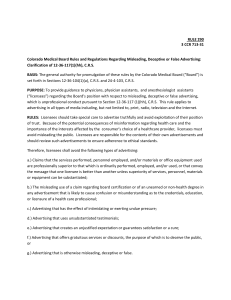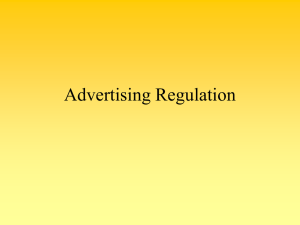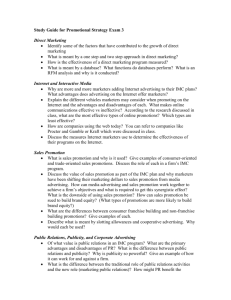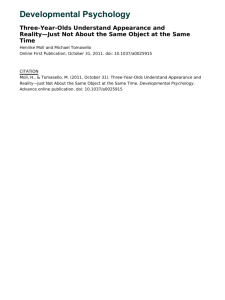1. According to a recent Inc. article on social responsibility
advertisement
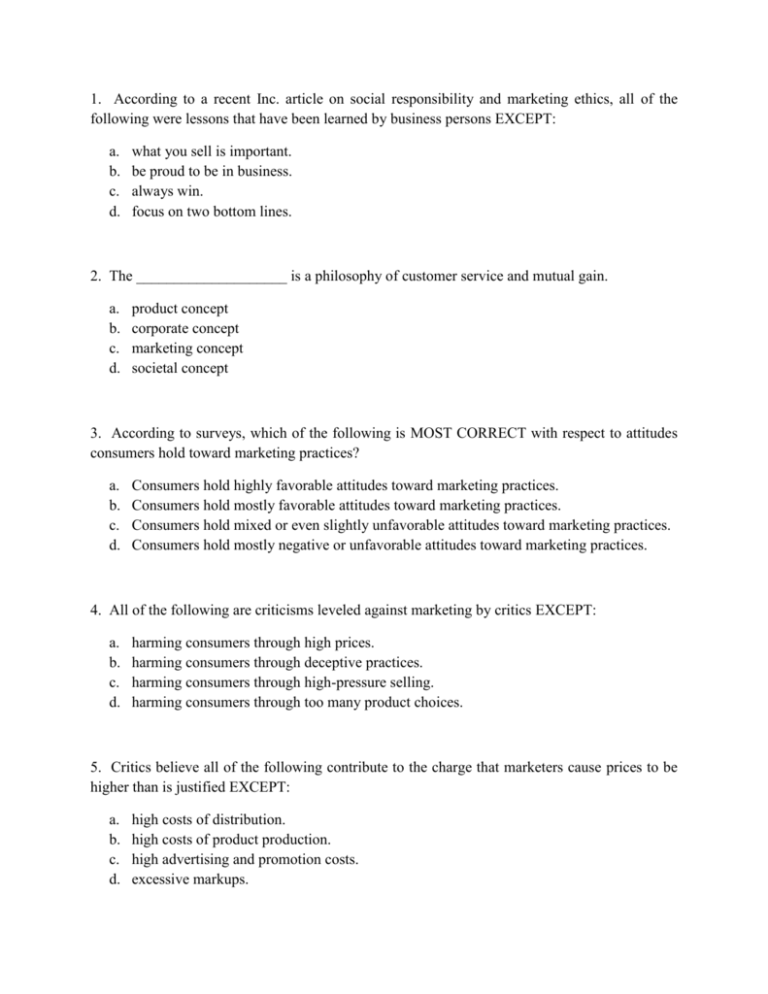
1. According to a recent Inc. article on social responsibility and marketing ethics, all of the following were lessons that have been learned by business persons EXCEPT: a. b. c. d. what you sell is important. be proud to be in business. always win. focus on two bottom lines. 2. The ____________________ is a philosophy of customer service and mutual gain. a. b. c. d. product concept corporate concept marketing concept societal concept 3. According to surveys, which of the following is MOST CORRECT with respect to attitudes consumers hold toward marketing practices? a. b. c. d. Consumers hold highly favorable attitudes toward marketing practices. Consumers hold mostly favorable attitudes toward marketing practices. Consumers hold mixed or even slightly unfavorable attitudes toward marketing practices. Consumers hold mostly negative or unfavorable attitudes toward marketing practices. 4. All of the following are criticisms leveled against marketing by critics EXCEPT: a. b. c. d. harming consumers through high prices. harming consumers through deceptive practices. harming consumers through high-pressure selling. harming consumers through too many product choices. 5. Critics believe all of the following contribute to the charge that marketers cause prices to be higher than is justified EXCEPT: a. b. c. d. high costs of distribution. high costs of product production. high advertising and promotion costs. excessive markups. 6. Among the social criticisms of marketing is high prices. The long-standing charge that greedy middlemen mark up prices beyond the value added by their services refers to which price-related criticism? a. b. c. d. high costs of distribution high advertising and promotion costs excessive markups low consumer demand 7. As an answer to the charge that distribution costs too much and that consumers pay for these excessive costs in the form of higher prices, resellers answer by saying: a. b. c. d. “if you want it, you have to pay for it.” “markups reflect services that consumers themselves want.” “lower prices are only possible with less quality or less service.” “perceptions of higher prices are simply incorrect.” 8. The criticism of marketing for packaging decisions that add “only” psychological value to products rather than functional value relates to which social criticism of marketing? a. b. c. d. high costs of distribution high advertising and promotion costs excessive markups high consumer demand 9. According to marketers, heavy advertising and promotion may be necessary for a firm to match competitor’s efforts to ensure that the company does not loose: a. b. c. d. its edge. its traditional approach to advertising. its share of mind. its budget percentage or allocation. 10. Pointing out the high cost of research and development efforts for new products like prescription drugs or high technology items is among the responses marketers provide in answer to which of the following criticisms of marketing? a. b. c. d. high costs of distribution high advertising and promotion costs excessive markups excessive demand 11. Marketers are sometimes accused of deceptive practices that lead consumers to believe they will get more value than they actually do. ______________ includes practices such as falsely advertising “factory” or “wholesale” prices or a large price reduction from a phony high retail price. a. b. c. d. Deceptive promotion Deceptive packaging Deceptive pricing Deceptive cost structure 12. Claiming a “wholesale price” as a reduction from a phony high list price is a form of: a. b. c. d. deceptive pricing. deceptive promotion. deceptive packaging. high pressure selling. 13. ________________ includes practices such as overstating the product’s features or performance, luring the customer to the store for a bargain that is out of stock, or running rigged contests. a. b. c. d. Deceptive promotion Deceptive packaging Deceptive pricing Deceptive cost structure 14. Misleading labeling is a form of: a. b. c. d. deceptive pricing. deceptive promotion. deceptive packaging. high pressure selling. 15. The organization that fights to regulate “unfair or deceptive acts or practices” is the: a. b. c. d. Department of Commerce. Robinson-Patman Act. Environmental Protection Agency. Federal Trade Commission. 16. The Wheeler-Lea Act gives the Federal Trade Commission the power to regulate: a. b. c. d. interstate commerce. marketing ethics. unfair and deceptive acts or practices. competitive advertising of product benefits. 17. The toughest problem the Federal Trade Commission has in regulating unfair or deceptive practices is: a. b. c. d. defining what is deceptive. getting Congressional support. dealing with enormous lobbying efforts. determining appropriate penalties for guilty parties. 18. Marketers argue that most companies avoid deceptive practices because: a. b. c. d. the company is almost always caught. such practices harm their business in the long run. such practices are difficult to cover up. the monetary penalty is almost always significant. 19. “Goods are sold, not bought” would be consistent with which of the following? a. b. c. d. high pressure selling the marketing concept the societal concept of marketing consumer wants and needs as shown through demand 20. A “three-day cooling off period” in which buyers can cancel a contract after rethinking the contract is designed to protect the consumer from: a. b. c. d. creative selling. high pressure selling. detail selling. hard core selling. Answer of MCQ 1-c 2-c 14-c 3-c 15-d 4-d 16-c 5-b 17-a 6-a 18-b 7-b 19-a 8-b 20-b 9-c 10-c 11-c 12-a 13-a 1. Today’s successful companies at all levels have one thing in common. The common theme can best be described as one where the companies are: a. b. c. d. oriented around public service. strongly customer focused and heavily committed to marketing. moving toward globalization and socialization. more interested in governmental regulation and control than ever before. 2. According to Bernie Marcus, cofounder of Home Depot, the Holy Grail of business is: a. b. c. d. the bottom line. promotion, promotion, and more promotion. an almost blind, passionate commitment to taking care of customers. meet every competitive threat with strength, commitment, and the courage to win. 3. Creating __________________ is at the very heart of modern marketing thinking and practice. a. b. c. d. profit maximization increased stock value award winning products customer value and satisfaction 4. The twofold goal of marketing is to attract new customers by promising superior value and: a. b. c. d. win advertising and industry awards for excellence. to keep and grow current customers by delivering satisfaction. enhance shareholder value. pay as few taxes as possible. Wal-Mart has become the world’s largest retailer by delivering on its promise, 5. “Always low prices—always.” This would be an example of the marketing philosophy that says: a. b. c. d. “Take care of your customers, and market share and profits will follow.” “Buy cheap, sell cheap.” “Always take discounts and pass some of them on to consumers.” “Distribution is the secret to all conquests in marketing.” 6. Today, marketing must be understood in a new sense that can be characterized as: a. b. c. d. “telling and selling.” “management of youth demand.” “get there first with the most.” “satisfying customer needs.” 7. _________________ is a social and managerial process by which individuals and groups obtain what they need and want through creating and exchanging products and value with others. a. b. c. d. Management Marketing Econometrics Demand 8. The most basic concept underlying marketing is that of: a. b. c. d. products and services. human needs. barter. transactions. 9. ____________ are states of felt deprivation. a. b. c. d. Demands Wants Needs Core transactions 10. Basic needs, such as those for food, clothing, and safety, refer to: a. b. c. d. physical needs. social needs. individual needs. physical wants. 11. __________ are shaped by one’s society and are described in terms of objects. a. b. c. d. Needs Wants Demands Transactions 12. When backed by buying power, wants become: a. b. c. d. needs. relationships. object relationships. demands. 13. In outstanding companies, people at all levels, including top management,: a. b. c. d. work more than eight hours a day. are constantly inventing new products. are addicted to time management. stay close to customers. 14. Anything that can be offered to a market for attention, acquisition, use, or consumption that might satisfy a want or need is called a: a. b. c. d. demand. basic staple. product. service. 15. A _______________ is any activity or benefit offered for sale that is essentially intangible and does not result in the ownership of anything. a. b. c. d. demand basic staple product service 16. If a company is guilty of “marketing myopia,” then it is: a. in danger of having dangerous cost overruns because it is trying to please too many diverse customer groups. b. so taken with its products that it focuses only on existing wants and loses sight of underlying consumer needs. c. guilty of prejudice toward certain customer groups. d. falling into the trap of “copying” rather than “inventing” products. 17. The difference between the values the customer gains from owning and using a product and the costs of obtaining the product is called ______________. a. customer quality b. customer satisfaction c. customer value d. perceptual relationships 18. Customers often do not judge product values and costs accurately or objectively. Instead, they act on ___________________. a. b. c. d. customer satisfaction customer quality needs perceived value 19. _________________ depend(s) on a product’s perceived performance in delivering value relative to a buyer’s expectations. a. b. c. d. Customer satisfaction Customer quality Customer value Customer needs 20. With respect to customer satisfaction, smart companies aim to: a. give the customer anything and everything they want. b. make customers addicted to their products and services. c. delight customers by promising only what they can deliver, then delivering more than they promise. d. always save the customers money, time, and other resources. Answer of MCQ 1-b 2-c 14-c 3-d 15-d 4-b 16-b 5-a 17-c 6-d 18-d 1 The purpose of a business is to: a. maximize short-term profit b. attract new customers 7-b 19-a 8-b 20-c 9-c 10-a 11-b 12-d 13-d c. boost short-term sales d. create and maintain profitable customers 2 The two main industries that comprise the activities we call tourism are: a. b. c. d. computer and Internet industries hospitality and travel industries fashion and accessories industries furniture and home improvement industries 3 Which of the following statements is true? a. b. c. d. The first basic concept of marketing is that of human wants. The second basic concept of marketing is that of human needs. A human need is part of the human makeup. A human need is invented by marketers. 4 All of the following statements are true, except: a. b. c. d. Anything capable of satisfying a need can be called a product. A Disneyland experience can be considered to be a product. The concept of product is limited to physical objects. Experiences, information, and ideas can be called products. 5 Which of the following are not considered part of the hospitality service industry? a. b. c. d. car rental companies hotels and motels travel agents and tour operators advertising agencies 6 All of the following statements are true, except: a. Costs include both monetary and non-monetary costs. b. If a product's performance falls short of the customers' expectations, the customers are dissatisfied. c. Marketers must be careful to set the right level of expectations. d. Marketers have no control of customers' expectations. 7 Which of the following statements is true? a. b. c. d. TQM stands for Tourism Quality Management. ROQ stands for Revenue On Quality. Quality begins with customer needs and ends with customer satisfaction. ROQ is an approach in which all the company's people are involved in constantly improving the quality, product, services, and business processes. 8 The __________________ holds that consumers will favor products that are available and highly affordable. a. b. c. d. production concept product concept selling concept marketing concept 9 _________ is most appropriate with customers who most affect the company's future. a. b. c. d. Transaction marketing Level marketing Relationship marketing Telemarketing 10 All of the following statements are true, except: a. The problem with manufacturing concept is that management may become so focused on manufacturing system that they forgot the customers. b. The product concept holds that consumers prefer existing products and product forms. c. The selling concept holds that customers will buy enough of the organization's products without a large selling and promotion effort. d. The marketing concept starts with the needs and wants of the company's target customers. Answer of MCQ 1-d 2-b 3-c 4-c 5-d 6-d 7-c 8-a 9-c 10-c 1 Sales promotions are primarily used to increase sales levels in the: a. medium term b. long term c. short term 2 Sales promotion is a promotional tool regarded as: a. b. c. d. through-the-line around-the-line above-the-line below-the-line 3 The credibility of a sales promotion event is usually: a. b. c. d. low of no consequence high medium 4 Of the following reasons, which is not a reason to use sales promotion? a. b. c. d. To develop brand image To assist integration To reward behaviour To reach new customers 5 Which of the following is NOT considered to be an objective associated with the use of sales promotions? a. Increase volume of individual purchases b. Prompt buyers into trial purchase c. Change buyer attitudes 6 Sales promotions are thought to make consumer purchase decisions: a. b. c. d. less satisfying simpler more satisfying more complex 7 If there is low involvement and the product/market is established then sales promotions should be used for: a. b. c. d. all to block out the competition loyals to reward and increase usage loyals to increase loyalty loyals to encourage trial 8 Levels of customer loyalty can be determined by attitudinal surveys. a. True b. False 9 Sales promotions can encourage people to purchase outside their usual repertoire. a. True b. False 10 Research suggests that the costs of sales promotions: a. b. c. d. outweigh any benefits are negligible are enormous are easily recouped 11 TPR stands for: a. temporary price reduction b. the promotion rate c. top promotional return 12 The main reason for manufacturers to use sales promotions when launching new products is to: a. b. c. d. establish distribution encourage trial increase sales develop loyalty 13 Which of the following is most important to resellers? a. Brand loyalty b. Store loyalty 14 'Count and recount' allowances give resellers discount on: a. stock returned after the promotion period b. stock bought in during the promotion period c. stock sold during the promotion period 15 Which of these is not a sales promotion technique? a. b. c. d. Questionnaire Bonus pack Coupon Loyalty card Answer of MCQ 1-c 2-d 14-c 3-a 15-a 4-a 5-c 6-b 7-b 8-b 9-b 10-a 11-a 12-a 13-b 1. Anything that can be offered to a market for attention, acquisition, use, or consumption that might satisfy a want or need is called a(n): a. b. c. d. idea. demand. product. service. 2. Broadly defined, products include all of the following EXCEPT: a. b. c. d. money and payments. services. ideas. persons. 3. A ______________________ is a form of product that consists of activities, benefits, or satisfactions offered for sale that are essentially intangible and do not result in the ownership of anything. a. b. c. d. service demand need physical object 4. All of the following are examples of services EXCEPT: a. b. c. d. banking. hotels and motels. tax preparation. computer software. 5. Examples of pure tangible goods include all of the following EXCEPT: a. b. c. d. soap. tax preparation. toothpaste. salt. 6. Which of the following would be the best illustration of a pure service? a. b. c. d. a water pick for cleaning teeth a doctor’s exam a waiter taking your order in a restaurant flying on an airline 7. If a company has a hybrid offer, then its offer may be described as being one where there is: a. b. c. d. an equal amount of goods and services. a tangible good with accompanying services. a service with accompanying minor goods. a clone service package. 8. A(n) _____________ occurs when a company intentionally uses services as the stage, and goods as the props, to engage individual customers in a way that creates a memorable event. a. b. c. d. hybrid offer core service augmented or ancillary product experience 9. The most basic level of a product is called the: a. b. c. d. core product. central product. fundamental product. augmented product. 10. All of the following are considered to be characteristics of the actual product category or feature EXCEPT: a. b. c. d. quality level. installation. brand name. design. Answer of MCQ 1-c 2-a 3-a 4-d 5-b 6-b 7-a 8-d 9-a 10-b
